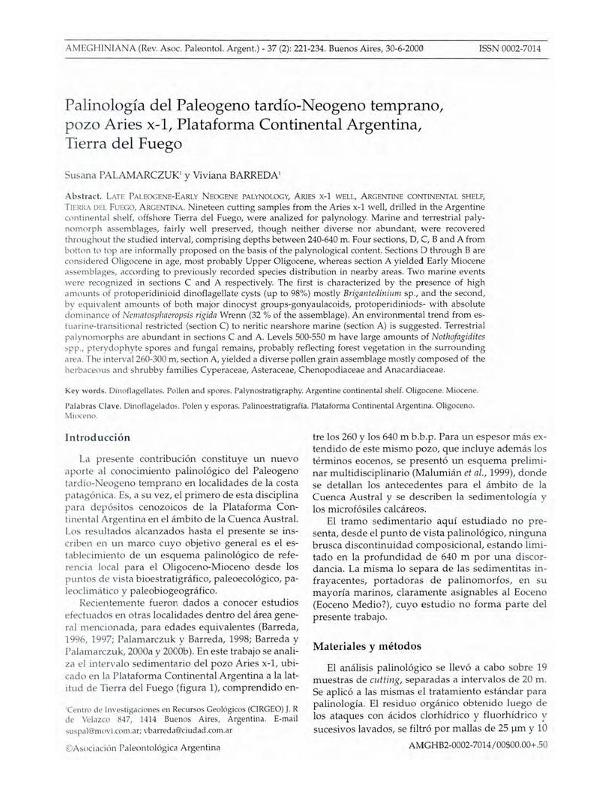Mostrar el registro sencillo del ítem
dc.contributor.author
Palamarczuk, Susana Carmen

dc.contributor.author
Barreda, Viviana Dora

dc.date.available
2019-03-15T18:55:22Z
dc.date.issued
2000-06
dc.identifier.citation
Palamarczuk, Susana Carmen; Barreda, Viviana Dora; Palinología del Paleogeno tardío-Neo geno temprano, pozo Aries x-l, Plataforma Continental Argentina, Tierra del Fuego; Asociacion Paleontologica Argentina; Ameghiniana; 37; 2; 6-2000; 221-234
dc.identifier.issn
0002-7014
dc.identifier.uri
http://hdl.handle.net/11336/71772
dc.description.abstract
Nineteen cutting samples from the Aries x-I well, drilled in the Argentine continental shelf, offshore Tierra del Fuego, were analized for palynology. Marine and terrestrial palynomorph assemblages, fairly well preserved, though neither diverse nor abundant, were recovered throughout the studied interval, comprising depths between 240-640 m. Four sections, D, e, B and A from botton to top are informally proposed on the basis of the palynological content. Sections D through B are considered Oligocene in age, most probably Upper Oligocene, whereas section A yielded Early Miocene assemblages, according to previously recorded species distribution in nearby areas. Two marine events were recognized in sections e and A respectively. The first is characterized by the presence of high amounts of protoperidinioid dinoflagellate cysts (up to 98%) mostly Brigantedinium sp., and the second, by equivalent amounts of both major dinocyst groups-gonyaulacoids, protoperidiniods- with absolute dominance of Nematosphaeropsis rigida Wrenn (32 % of the assemblage). An environmental trend from estuarine- transitional restricted (section C) to neritic nearshore marine (section A) is suggested. Terrestrial palynomorphs are abundant in sections e and A. Levels 500-550 m have large amounts of Nothofagidites spp., pterydophyte spores and fungal rernains, probably reflecting forest vegetation in the surrounding area. The interva1260-300 m, section A, yielded a diverse pollen grain assemblage mostly composed of the herbaceous and shrubby families Cyperaceae, Asteraceae, Chenopodiaceae and Anacardiaceae.
dc.format
application/pdf
dc.language.iso
spa
dc.publisher
Asociacion Paleontologica Argentina

dc.rights
info:eu-repo/semantics/openAccess
dc.rights.uri
https://creativecommons.org/licenses/by-nc-sa/2.5/ar/
dc.subject
Dinoflagelados
dc.subject
Polen
dc.subject
Palinoestratigrafía
dc.subject
Plataforma
dc.subject.classification
Paleontología

dc.subject.classification
Ciencias de la Tierra y relacionadas con el Medio Ambiente

dc.subject.classification
CIENCIAS NATURALES Y EXACTAS

dc.title
Palinología del Paleogeno tardío-Neo geno temprano, pozo Aries x-l, Plataforma Continental Argentina, Tierra del Fuego
dc.type
info:eu-repo/semantics/article
dc.type
info:ar-repo/semantics/artículo
dc.type
info:eu-repo/semantics/publishedVersion
dc.date.updated
2019-03-14T14:15:00Z
dc.identifier.eissn
1851-8044
dc.journal.volume
37
dc.journal.number
2
dc.journal.pagination
221-234
dc.journal.pais
Argentina

dc.journal.ciudad
Ciudad Autónoma de Buenos Aires
dc.description.fil
Fil: Palamarczuk, Susana Carmen. Consejo Nacional de Investigaciones Científicas y Técnicas. Centro de Investigaciones en Recursos Geológicos (i); Argentina
dc.description.fil
Fil: Barreda, Viviana Dora. Consejo Nacional de Investigaciones Científicas y Técnicas. Centro de Investigaciones en Recursos Geológicos (i); Argentina
dc.journal.title
Ameghiniana

dc.relation.alternativeid
info:eu-repo/semantics/altIdentifier/url/http://www.ameghiniana.org.ar/index.php/ameghiniana/article/view/2537
Archivos asociados
